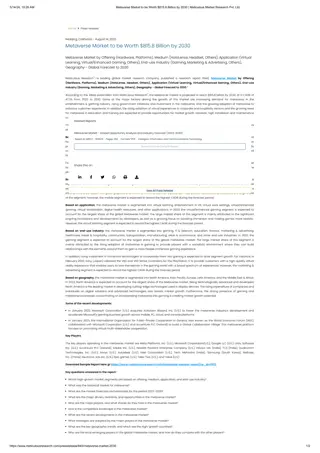Understanding MPAI's Role in Metaverse Interoperability
MPAI, spearheaded by Leonardo Chiariglione, plays a crucial role in defining standards and technologies for the metaverse, ensuring interoperability between different metaverse instances. This involves functional and prescriptive interoperability, enabling seamless data exchange and operation models. The focus is on creating a common ground for diverse technologies to coexist and communicate effectively within the metaverse landscape.
Download Presentation

Please find below an Image/Link to download the presentation.
The content on the website is provided AS IS for your information and personal use only. It may not be sold, licensed, or shared on other websites without obtaining consent from the author. Download presentation by click this link. If you encounter any issues during the download, it is possible that the publisher has removed the file from their server.
E N D
Presentation Transcript
MPAI Metaverse Model (MPAI-MMM) - Architecture Leonardo Chiariglione 15 UTC 15 March 2024 . 1 17-Apr-24
What is the business of MPAI with the metaverse? Metaverse is the ultimate shape of the digitisation process of the last 100 years The design of metaverse requires many sophisticated media coding technologies 2 17-Apr-24
What is MPAIs relationship with the Metaverse? Industry interest in the Metaverse New jobs-opportunities-experiences. Standards & AI main drivers for the development of the Metaverse MPAI is in both. A variety of standards needed MPAI has already quite a few. Metaverse requires more standards MPAI has technologies and may develop more. Technology integration for metaverse MPAI develops reference software. 3 17-Apr-24
What does metaverse interoperability mean? Prescriptive interoperability (as in media). The metaverse context is fast-evolving; technology has many configurations. Standard format Metaverse Instance #1 Metaverse Instance #2 Mediated interoperability. Format1 Format2 Format Conversion Service Metaverse Instance #1 Metaverse Instance #2 Format1 Format2 Conversion services do not guarantee interoperability for all cases. 17-Apr-24
Functional interoperability In general, data format conversion is possible when data formats reference the same functionalities. We should specify the functional requirements of: The data provided by an M-Instance to another M- Instance or to a Device. The operation model of an M-Instance. The operation model of an M-Instance. In general, data format conversion is possible when data formats reference the same functionalities. We should specify the functional requirements of: The data provided by an M-Instance to another M- Instance or to a Device. dataA.1 dataA.1 dataB.1 dataB.1 dataB.1 dataA.1 dataB.2 ? Functional interoperability enables the conversion of data with the format of M-InstanceA to data with the format of M-InstanceB. 5 17-Apr-24
Scope of MPAI Metaverse Model (MPAI-MMM) Architecture Enables Interoperability of two or more M-Instances if they: 1. Rely on the Operation Model 2. Use the same Profile Architecture, 3. and 1.Either the same technologies, or 2.Independent technologies if Conversion Services to losslessly transform Data of an M- InstanceAto Data of an M- InstanceB. Note: Full Interoperability may not be achieved if the M-Instances implement different Profiles. 6 17-Apr-24
MPAI-MMM Architecture Table of Contents Introduction Scope Definitions References Functionalities Operation Model Functional Requirements Processes Actions Items Data Types Scripting Language Use Cases Functional Profiles 7 17-Apr-24
1 M-Instance Functionalities of MPAI-MMM Architecture 2 Processes 3 Rules 4 Registration 5 Rights 5.1 General Rights 5.2 Perception Rights 5.3 Interaction Rights 5.4 Service access Rights 5.5 Acquisition of Rights 6 Personae 7 Locations 8 Objects and Scenes 9 Identifiers 8 17-Apr-24
MPAI-MMM Architecture 9 17-Apr-24
1. Senses data from U-Locations. 2. Processes the sensed data and produce Data. 3. Produces 1 M-Environments populated by Objects that can be either digitised or virtual, the latter with or without autonomy. 4. Processes Objects from the M-Instance or potentially from other M-Instances. 5. Affects U- and/or M-Environments using Objects in ways that are: 1. Consistent with the goals set for the M- Instance. 2. Within the Capabilities of the M- Instance. 3. According to the Rules of the M-Instance. 4. Respecting applicable laws and regulations. 6. Operates according to and provides the Functionalities of this Technical Specification. M-Instance: ICT platform performing the functions: 10 17-Apr-24
M-Instance Operation Model/1 An M-Instance: 1. May make its Capabilities known. 2. May be administratively subdivided in M-Environments. 3. May allow a human to Register with the M-Instance or an M-Environment. 4. May request a Registering human to provide a subset of their Personal Profile. 5. Is implemented as a set of Processes: 1. Providing Functionalities defined by this Technical Specification. 2. Composed of: 1.A Program having a Format supported by the M-Instance. 2.Metadata describing the Program and containing the following as a minimum: 11 17-Apr-24
M-Instance Operation Model/2 Table 2 - Minimum Metadata set of a Process Metadata elements ProcessID UserID InRightsID OutRightsID DescrMdata Details The ID of the Process. The ID of the User having Rights to Act on the Process. The ID of the User s Rights to Act granted to the Process. The ID of the Rights a User may acquire on the Process. Any description of the Process. 12 17-Apr-24
M-Instance Operation Model/3 (Is implemented as a set of Processes) 3.Performing Actions on Items if they hold the Rights to do that. 4. Requesting other Processes to perform Actions by transmitting a standard Request-Action Item and responding to a Request-Action with a Response-Action: Request-Action Request-Action ID Emission Time Source Process ID Destination Process ID InItems InLocations OutLocations OutRights Response-Action Response-Action ID Emission Time Source Process ID Destination Process ID Requested Process ID OutItems Details Unique ID Tine of Issuance Requesting Process ID In/Output Items required by the Action Locations of InItems Locations of OutItems Expected Rights on OutItems 13 17-Apr-24
M-Instance Operation Model/7 (Is implemented as a set of Processes) 5. Performing the Request if: 1.The requesting Process holds the Rights that are required to perform the request. 2.The requested Process holds Rights to perform the requested Action on the Item. 6. Enables a Process: 1. To communicate to a Process in another M-Instance through an M-Instance s Resolution Service. 2. To obtain conversion of the Format of an Item s Data by calling a Conversion Service. 3. To specify their communication needs by: 1.Requesting the needed maximum and average bitrate value. 2.Reserving the needed bitrate for a time and a location. 3.Requesting that the same simultaneous Experience be provided to a specified number of Devices. 14 17-Apr-24
M-Instance Operation Model/8 Request-ActionA1 Resolution ServiceA Resolution ServiceB Response-ActionA2 Response-ActionA3 Response-ActionA2 Request-ActionA1 Request-ActionA1 ProcessA3 ProcessB2 ProcessA2 ProcessA1 ProcessA4 ProcessB1 ProcessB4 ProcessB3 M-InstanceA ItemA3 ItemA2 ItemA1 ItemA2 M-InstanceB Conversion Service Conversion Service 15 17-Apr-24
M-Instance Operation Model/9 7. May support four types of Process: 1. Device is one or more Processes running on a physical device connecting M- Locations to U-Locations, specifically the Registered human, by: 1.Capturing scenes as Media and providing Media as Data/Metadata U-Location to M- Location). Data/Metadata shall be Identified as an Item to enable Processes to perform Actions. 2.Receiving an Entity and rending it as Media with a Spatial Attitude (Position and Orientation) M-Location to a U-Location. 2. The User Process represents and is under the control of a human Registered with the M-Instance. A User may run on the M-Instance or on a Device connected to the M-Instance. 3. Service provides specific functionalities. 4. App runs on a Device. A Device may run the User Process as an App. 16 17-Apr-24
M-Instance Operation Model/10 Metaverse Universe App User Persona Process Human Device User 17 17-Apr-24
M-Instance Operation Model/11 8. Provides Functionalities through Processes performing Actions on Items containing: 1. Data whose Format is supported by the M-Instance. 2. Metadata describing the Item and containing the following as a minimum: Table 4 - Minimum Metadata for Item Metadata elements ItemID UserID DescrMdata Details The ID of the Item. The ID of the User having Rights to Act on the Item. Any description of the Item. 18 17-Apr-24
M-Instance Operation Model/12 9. Identifies Processes/Items with one Identifier and, optionally, with more than one Identifier. Each Identifier uniquely refers to one Process/Item. 10.Creates Items by processing the sensed data and the autonomously produced data. 11.Employs Data Types to represent entities such as Amount (of a Currency), length, area, volume, etc. 12.Gives a Registered human the Rights to deploy one or more: 1. Users and Devices each with M-Instance-specific Rights. 2. Personae, i.e., human-like, or humanoid Models used by deployed Users to render themselves. 13.Establishes Rules that the Users in the M-Instance shall comply with. 19 17-Apr-24
M-Instance Operation Model/13 14. May penalise Users for lack of compliance with the Rules. 15.May allow a Process to perform, or request another Process to perform, Actions on Items even in the absence of Rights. 16.May require that Processes be certified for use in the M-Instance. Future versions of this document may specify: 1. Profiles and Levels of Actions and Items. 2. Additional Actions, Items, and Data Types. 20 17-Apr-24
Functional Requirements: Processes 21 17-Apr-24
Functional Requirements: Processes 1 App 2 Device 3 Service 4 User 22 17-Apr-24
1 General Actions 2 Call a Service Functional Requirements: Actions/1 1.1 Register 2.1 Author 1.2 Change 2.2 Discover 1.3 Hide 2.3 Inform 1.4 Authenticate 2.4 Interpret 1.5 Identify 2.5 Post 1.6 Modify 2.6 Transact 1.7 Validate 2.7 Convert 1.8 Execute 2.8 Resolve 23 17-Apr-24
3 Metaverse to Metaverse 4 Metaverse to Universe Functional Requirements: Actions/2 3.1 MM-Add 4.1 MU-Actuate 3.2 MM-Animate 4.2 MU-Render 3.3 MM-Disable 4.3 MU-Send 3.4 MM-Embed 4.4 Track 5 Universe to Metaverse 3.5 MM-Enable 3.6 MM-Send 5.1 UM-Animate. 5.2 UM-Capture. 5.3 UM-Render 5.4 UM-Send 24 17-Apr-24
1 General 1.1 M-Instance 1.2 M-Capabilities 1.3 M-Environment 3.3 1.4 Identifier 1.5 Rules 1.6 Rights 1.7 Program 1.8 Contract 2 User 2.1 Account 2.2 Activity Data 2.3 Personal Profile 4.7 2.4 Social Graph 2.5 Personal Data 3 Interaction 3.1 Message 3.2 P-Capabilities Request-Action 3.4 Response-Action 4 Service Access 4.1 AuthenticateIn 4.2 AuthenticateOut 4.3 DiscoverIn 4.4 DiscoverOut 4.5 InformIn 4.6 InformOut InterpretIn 4.8 InterpretOut Functional Requirements: Items/1 25 17-Apr-24
Functional Requirements: Items/2 5 Finance 5.1 Asset 5.2 Ledger 5.3 Provenance. 5.4 Transaction 5.5 Value 5.6 Wallet 7 Space 7.1 M-Location 7.2 U-Location 6 Perception 6.1 Event 6.2 Experience 6.3 Interaction 6.4 Map. 6.5 Model 6.6 Object 6.7 Scene 6.8 Stream 6.9 Summary 26 17-Apr-24
Functional Requirements: Data Types 1 For location/time 2 For Transactions 1.1 Address 2.1 Amount 1.2 Coordinates 2.2 Currency 3 For internal state 1.3 Orientation 1.4 Point of View 3.1 Cognitive State 1.5 Position 3.2 Emotion 1.6 Spatial Attitude 3.3 Social Attitude 1.7 Time 3.4 Personal Status 27 17-Apr-24
Use Cases/1 MPAI has developed MPAI-MMM Architecture based on 18 application domains. Automotive Enterprise Finance Healthcare Real estate Social media Defence eSports Food Hospitality Remote work Travel Education Events Gaming Professional training Retail Virtual spaces 28 17-Apr-24
Use Cases/2 After developing MPAI-MMM Architecture, MPAI has used 9 use cases to test the specification. To do this efficiently, MPAI has developed a language MMM-Script to analyse all the steps of eaxh Use Case. 29 17-Apr-24
Use Case Scripting Language (MMM-Script) 1. In a Use Case: 1.Processes (e.g., Users) are sequentially identified by one subscript. 2.Items Acted on by a Process are identified by Process subscript & sequential number. 3.Locations are identified by Process subscript & sequential number. 4.Actions in different M-Instances, Processes/Items/Locations are prefixed by a letter. 2. For instance: 1.UseriMM-Embeds Personai,jat M-Locationi.k. 2.UseriMU-Renders Entityi,jat U-Locationi.k. 3.UserA,iMM-Sends ObjectA,i.jto UserB.k. 30 17-Apr-24
Nine Use Cases 5 5.1 Description 5.2 MMM-Script representation 5.3 Actions, Items, and Data Types Hybrid working 3 3.1 Description 3.2 MMM-Script representation 3.3 Actions, Items, and Data Types Virtual Lecture. 4 4.1 Description 4.2 MMM-Script representation 4.3 Actions, Items, and Data Types Virtual Meeting 8 8.1 Description 8.2 MMM-Script representation 8.3 Actions, Items, and Data Types AR Tourist Guide 6 6.1 Description 6.2 MMM-Script representation 6.3 Actions, Items, and Data Types eSports Tournament 7 7.1 Description 7.2 MMM-Script representation 7.3 Actions, Items, and Data Types Virtual performance 9 9.1 Description 9.2 MMM-Script representation 9.3 Actions, Items, and Data Types Virtual Dance 10 Virtual Car Showroom 10.1 Description 10.2 MMM-Script representation 10.3 Actions, Items, and Data Types 11 Drive a Connected Autonomous Vehicle 11.1 Description 11.2 MMM-Script representation 11.3 Actions, Items, and Data Types 31 17-Apr-24
Functionality Profiles High Profile Management Profile Finance Profile Baseline Profile 32 17-Apr-24
Baseline Profile Enables a human equipped with a Device supporting the Baseline Profile to allow their Users to perform the functions of following Table. Supports basic forms of lecture, meeting, and hang-out. Has the following Levels: Audio only Audio-Visual Audio-Visual-Haptic. 33 17-Apr-24
Basic Profile: Actions, Items, and Data Types Author MM-Disable MU-Render UM-Capture Identifier Model U-Location Identify MM-Enable MU-Send UM-Render Message Object MM-Add MM-Send Track UM-Send M-Instance Scene MM-Embed MU-Actuate UM-Animate Actions M-Location Stream Items Data Types Address Coordinates Orientation Position Spatial Attitude 34 17-Apr-24
Finance Profile: Actions, Items, and Data Types Authenticate Hide MM-Disable Modify Post UM-Render Account Ledger M-Instance Personal Profile DiscoverIn Rights Stream Value Address Orientation Author Identify MM-Embed MU-Actuate Register UM-Send Activity Data Map M-Location Provenance DiscoverOut Rules Transaction Wallet Amount Position Change Inform MM-Enable MU-Render Transact Discover MM-Add MM-Send MU-Send UM-Capture Actions Asset M-Environment Model AuthenticateIn InformIn Scene U-Location Identifier Message Object AuthenticateOut InformOut Social Graph Personal Data Items Data Types Coordinates Spatial Attitude Currency Time 35 17-Apr-24
Management Profile: Actions, Items, and Data Types Authenticate Hide MM-Add MM-Enable MU-Render Track UM-Render Account AuthenticateOut Experience Interaction Map M-Location Provenance Social Graph U-Location Address Currency Personal Status Spatial Attitude Author Identify MM-Animate MM-Send MU-Send Transact UM-Send Activity Data DiscoverIn Identifier InterpretIn M-Environment Model Rights Stream Value Amount Emotion Point of View Time Change Inform MM-Disable Modify Post UM-Animate Discover Interpret MM-Embed MU-Actuate Register UM-Capture Actions Asset DiscoverOut InformIn InterpretOut Message Object Rules Summary Wallet Cognitive State Map Position AuthenticateIn Event InformOut Ledger M-Instance Personal Profile Scene Transaction Items Data Types Coordinates Orientation Social Attitude 36 17-Apr-24
High Profile: New Actions, Items, and Data Types Actions Item Data Types Convert Contract Execute M-Capabilities P-Capabilities Resolve Validate Program 37 17-Apr-24
Join MPAI Share the fun Build the future We look forward to working with you on this exciting MPAI project! https://mpai.community/ 38 38 38 38 38 17-Apr-24























